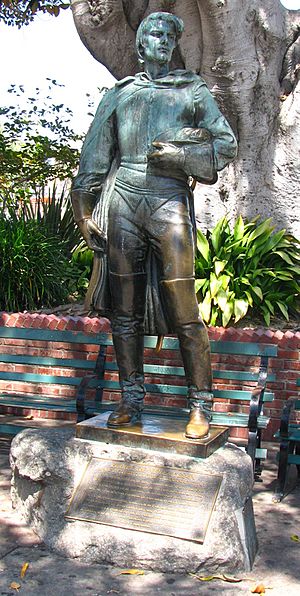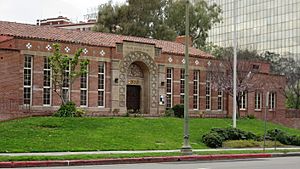Felipe de Neve facts for kids
Quick facts for kids
Felipe de Neve
|
|
|---|---|

Statue of Neve in the Los Angeles Plaza.
|
|
| 4th Governor of the Californias | |
| In office 1777–1782 |
|
| Preceded by | Fernando Rivera y Moncada |
| Succeeded by | Pedro Fages |
| Personal details | |
| Born | 1724 Bailén, Province of Jaén (Spain) |
| Died | November 3, 1784 Chihuahua, Mexico |
| Occupation | Explorer and politician |
| Military service | |
| Allegiance | Spain |
Felipe de Neve y Padilla (1724–1784) was an important Spanish soldier and leader. He served as the 4th Governor of the Californias from 1777 to 1782. Neve is known as one of the founders of Los Angeles, and he also helped start San Jose and Santa Barbara.
Contents
Early Life and Military Career
Growing Up in Spain
Felipe de Neve was born in Bailén, Spain, in 1724. His family was well-respected in the region of Andalusia. He joined the military when he was about 16 years old, in 1744.
Neve served as a soldier in different parts of Europe, including Cantabria, Flanders, Milan, and Portugal. Later, he traveled to New Spain, which is now Mexico. There, he worked as a major and managed colleges in Zacatecas.
Becoming Governor of Las Californias
On October 18, 1774, Neve was chosen to be the acting Governor of Las Californias. This large area included what is now California and Baja California. For his first two years, Neve worked from Loreto, Baja California. Later, he moved his base to Monterey, California.
Governing Las Californias
Founding New Settlements
During Governor Neve's time, several important places were established. In 1776, Lieutenant José Joaquín Moraga helped build the Presidio of San Francisco. A presidio was a Spanish military fort.
Moraga also founded El Pueblo de San José de Guadalupe on November 29, 1777. This is the city we know today as San Jose, California. It was the first Spanish town in the northern part of Las Californias. San Jose was created to grow food for the soldiers at the San Francisco and Monterey forts.
Planning Los Angeles
In 1781, Governor Neve founded the Pueblo de Los Ángeles. He asked the Viceroy (a high-ranking Spanish official) for permission to create a settlement near the Los Angeles River. This river was first seen by Father Juan Crespí in 1769.
With the King of Spain's approval, Neve was allowed to establish the second town in upper Las Californias. Its full name was El Pueblo de Nuestra Señora la Reina de los Ángeles del Río de Porciúncula. Today, it is the city of Los Angeles, California. Neve himself drew the plans for the town, making him one of the first urban planners in the area.
The place chosen for Los Angeles was already home to Tongva Native Americans. Father Crespi described them as "very docile and friendly." Neve arrived in 1779 and helped select people to move to the new town. On September 4, 1781, Los Angeles was officially founded.
Rules for New Towns
In 1781, Neve also wrote the "Reglamento para el gobierno de la provincia de Californias." These were the first rules for how towns like Los Angeles should be governed. They helped organize the new settlements.
Other Missions and Presidios
During his time as governor, Neve had disagreements with Padre Junípero Serra, a leader of the missions. They disagreed about how to manage the missions and distribute land to the Native Americans who lived there.
Four missions were founded during Neve's governorship:
- Mission San Francisco de Asís (June 29, 1776)
- Mission San Juan Capistrano (November 1, 1776)
- Mission Santa Clara de Asís (January 12, 1777)
- Mission San Buenaventura (March 31, 1782)
Neve also received orders to build a fort (presidio) at Santa Barbara. These new settlements aimed to provide land and water for farming.
Neve's View on Native Americans
A French explorer named Jean-François de la Pérouse visited California in 1786. He wrote about how Native Americans were treated at the missions. He noted that Governor Neve, who had passed away a few years earlier, was a very humane and thoughtful person.
La Pérouse said that Neve believed the Christian faith would spread better if Native Americans were not forced to convert. He wanted them to have more freedom and less harsh treatment. Neve thought that a special leader should be appointed to protect Native Americans from unfair treatment. He believed that military rule needed to be balanced with other powers to prevent cruelty.
Later Life and Recognition
Felipe de Neve was honored with the Cross of the Order of San Carlos and became a Brigadier General. His success as governor led to a promotion in 1783. He became the Commander General of the Internal Provinces, which meant he was in charge of all the northern Spanish territories, including Las Californias.
He held this important position until he passed away on November 3, 1784, in Chihuahua, Mexico.
Legacy and Honors
Statue in Los Angeles
A large statue of Felipe de Neve stands in La Plaza Park in Los Angeles. It was put there in 1932 by the City of Los Angeles. The statue has a bronze plaque that explains his role in founding Los Angeles. It says he selected the site and planned the town in 1781, following orders from King Charles III of Spain.
Other Tributes
The town that Neve helped found was officially declared a city by the Mexican Congress on May 23, 1835.
Several places in Los Angeles are named after him:
- De Neve Drive in the Westwood neighborhood.
- The De Neve Plaza student housing buildings at the University of California, Los Angeles.
- The Felipe de Neve Branch Library, part of the Los Angeles Public Library, located in Westlake.
See also
 In Spanish: Felipe de Neve para niños
In Spanish: Felipe de Neve para niños


